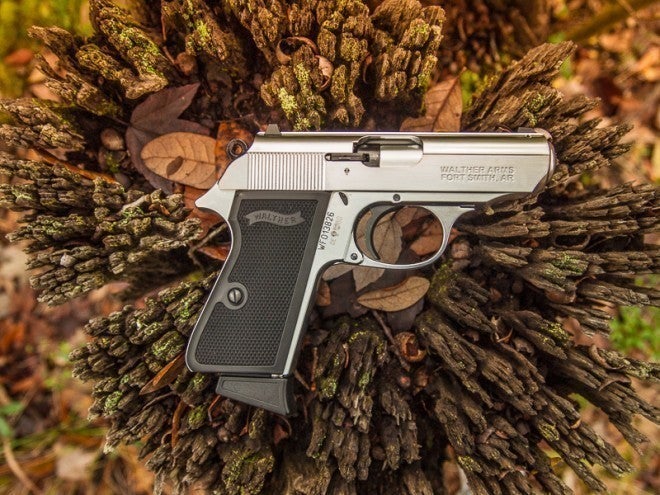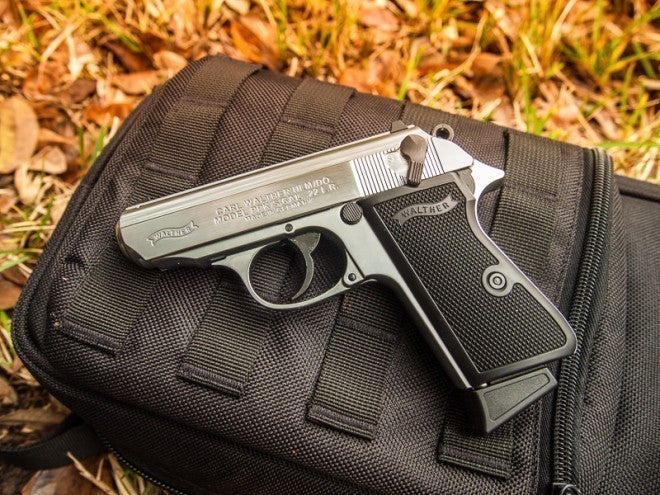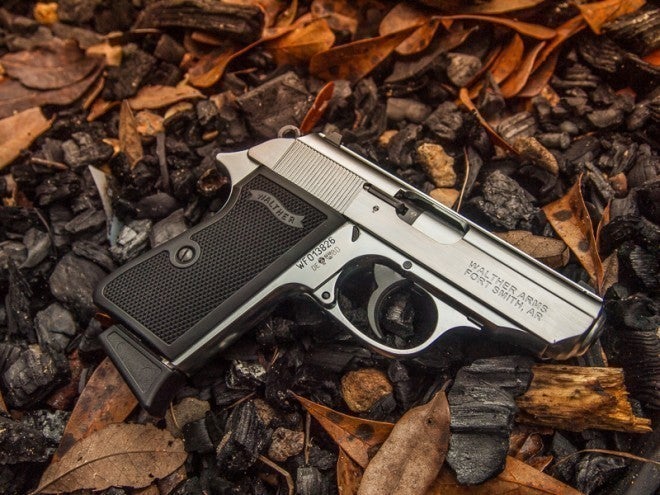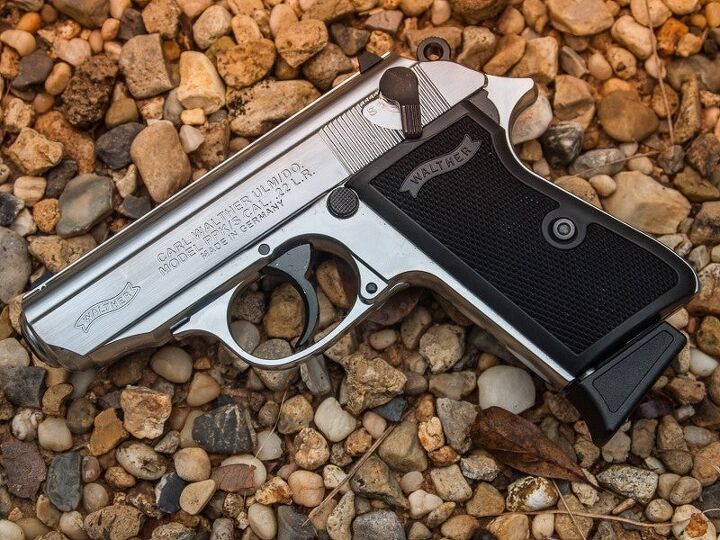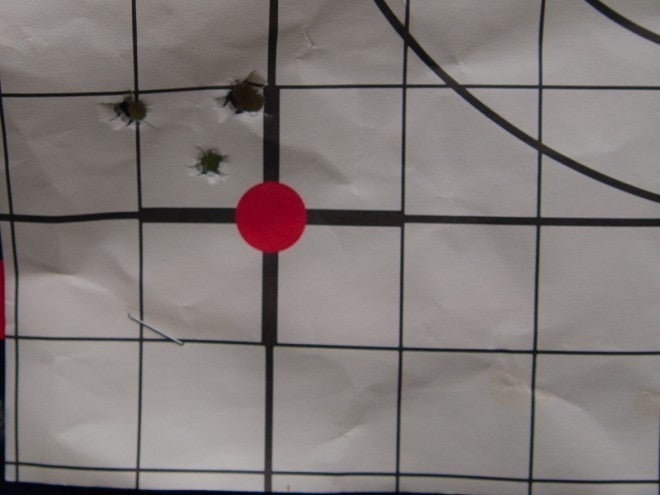It’s likely that every review of Walther’s new PPK/S .22LR will include some Bond reference – and why shouldn’t they? Bond made the PPK/S iconic, and according to Walther’s marketing team, the PPK/S .22 was re-introduced due to a re-kindled Bond fervor. This is certainly in no small part due to (a) Daniel Craig’s surprising fittedness in the role and (b) the re-introduction of the PPK as Bond’s sidearm in Skyfall. (Please ignore the fact that the Skyfall PPK had three LEDs that would have likely blinded the operator when in use). To give you some background that likely won’t be covered in other articles on this variation of the PPK: Ian Fleming, Bond’s creator, was issued the diminutive and hardly-lethal “Baby Browning” .25ACP when Fleming served in WWII-era Naval Intelligence. Resultantly, Fleming’s James Bond carried the similarly non-lethal .25ACP Beretta 418 because Fleming considered that appropriate (although he confessed in print that his firearm-related knowledge was extremely limited). Boldly, Geoffrey Boothroyd, a firearm expert and prolific writer himself, wrote Fleming to inform him that the 418 was “a lady’s gun”, and instead suggested that Bond carry the more powerful S&W Airweight revolver instead. When Fleming insisted on an automatic, Boothroyd suggested the PPK in .32/7.65mm. Consequently, in Dr. No, a service armorer named “Major Boothroyd” made a brief appearance to issue Bond his new PPK. While Fleming immortalized Boothroyd out of gratitude, he and Boothroyd also inadvertently propelled the PPK to legend status. Fifty-five years later, the Bond franchise is going strong, its fans prompting the Stateside re-introduction of the PPK/S in .22LR.

The author’s Manhurin (French) Walther PPK/S with AWC Archangel T silencer. The PPK/S in .22 was available in the states several decades ago, but it stopped being imported in recent history.
On January 1, 2013, Walther Arms, Inc. took over the distribution of Walther guns from Smith & Wesson, and even more recently, began importing the Walther PPK/S. “Importing” in the sense that these are German-made, right in Walther’s Arnsberg, Germany plant. Those readers with a flair for the teutonic will immediately notice the Ulm and Cologne proofmarks as well as the German date codes. They certainly look good and proudly display their German pedigree, but what are these guns made of, and how do they shoot?
Specifications:
The new PPK/S .22LR comes in a black or nickel-plate finish with a 3.3″ barrel and an OAL of 6.1″. It’s .98″ thin and 4.9″ tall. It is 1.5 lb. in weight, dry, which is not bad for an all-metal .22. (Consider the standard Ruger Mark III, which is well over 2 lb.). The PPK/S has adjustable sights, and includes one 10rd magazine. The D/A trigger pull is 17.5 lb., and the crisp single-action pull is 6.6 lb. The integrated thumb safety acts as both a safety and decock lever for the hammer. A copy of the owner’s manual can be found here.
The slide is made from a zinc alloy that Walther chose because it was both “durable” and “lightweight” according to my contact at Walther. While it would be best if everything was made of steel, as many of us know, steel slides don’t lend themselves to reliability in simple blow-back .22LR pistols – the light round rarely has enough power to push the slide rearward, extract a round, cock the hammer, and strip a new round clean into battery from the top of a mag. Thus, compromises have to be made in construction. Fortunately, the slide seems more than sturdy enough for its intended purpose and caliber.
Also a huge plus for us suppressor owners – similar to the P22, the end of the barrel conceals internal muzzle threads that can be exposed for attachment of a thread adapter. Simply use the included wrench to remove the thread protector, spin on your adapter with the correct pitch, and you are ready to thread on a silencer.
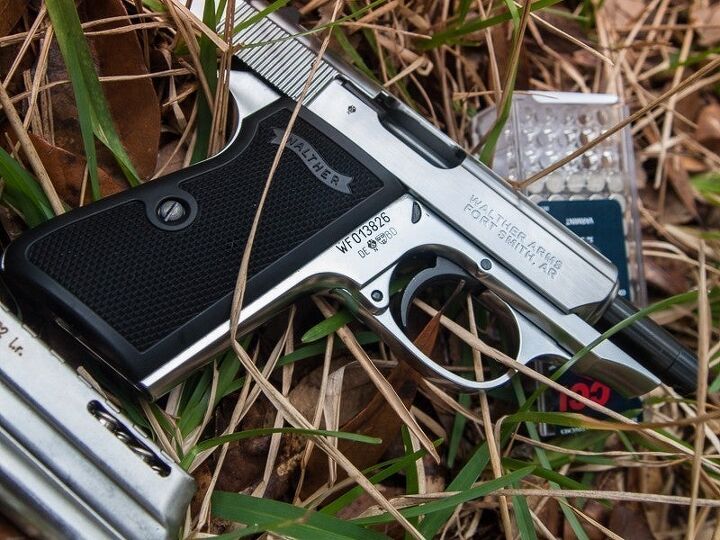
The seam where the thread protector covering the muzzle threads of the barrel can be seen in this picture.
General Observations:
The appearance of the PPK/S .22 is striking – it’s a very handsome pistol right out of the box, and fit and finish are excellent. The gun is tight without any slide play or rattles. It looks, feels, and operates just like any other PPK you’ve ever had, down to the lack of a slide release lever (just pop the mag out while pulling the slide rearward) and – one of my favorite features – striations along the very top center of the slide that reduce glare. It’s brilliant that Walther stayed so faithful to the original PPK design. Takedown for field stripping is identical to any other PPK, and it even takes the same grip panels as the original PPK/S. Rear slide serrations are clean and aggressive, and the polymer grip panels are very well defined and feel robust. All in all, this appears to be a well-designed pistol that faithfully emulates its progenitor, justifiably banking upon the PPK/S’s decades of service, rather than attempting to reinvent the wheel.
Unlike other modern reciprocating-slide .22s, this pistol feels like an actual handgun – not just a range toy. This is certainly related to the PPK/S .22’s near-identicality to its “big” brothers. So it looks good, but does the PPK/S .22 shoot well?
The PPK/S .22 is the same 1:1 scale as a regular PPK/S – this is not a shrunken-down copy like many other .22 variations of a full size gun. The standard PPK/S is hardly large, however, so if you have big hands, you may struggle a bit with the compact chassis, although the pinky extension on the included magazine helps. I thought the ergonomics were excellent, and that the PPK/S .22 “pointed” well.
The first thing you may notice are the narrow and non-contrasting sights. The PPK/S .22 sights are not the best, but they are definitely functional once you track them down. Some orange or white paint on the front sight might remedy this problem. As stated earlier, the very top of the slide is bisected by a thoughtful striated embossment that serves to stamp out any glare that might emanate from the top of the slide otherwise. It’s a nice touch, and faithful to the PPK design.
We ran 200 rounds of CCI Stinger through this PPK/S, and around 100 Remington bulk pack rounds. Once again, the Walther surprised me, performing more like a service handgun than a range toy. There were no malfunctions to speak of other than the one I inadvertently caused. More on that later, though. My point is this gun ran reliably with no maintenance on our end – I received it, took it out of the box, and then straight to the range. Accuracy was excellent for a gun this size. Freehanded, casual shooting at 10 yards easily resulted in ten of ten rounds going into a two inch by two inch square. The best group of the day was a five shot group, free-handed at ten yards, that ran about one inch across:
Accuracy was no doubt helped by the excellent trigger. There is a minimal amount of take-up slack – maybe a couple of millimeters – before a nice, crisp 6lb. break to fire the shot in single action.
As far as the one hangup I experienced, which was a slight FTF after the very first shot: Bear in mind, the .22LR does not generate very much force, so, any impediment of the slide will be exaggerated versus a full-size or large caliber pistol. Accordingly, “thumbs-forward” shooters should be mindful not to rest or drag their dominant thumb along the slide. I shifted to a “support thumb up” grip which allowed me to rest my dominant thumb on the frame, and there were no more issues after that.
In all, this was a joy to shoot – light recoil, reliable, and an excellent trigger. This is a fun plinker that is handsome, to boot. Also, the internal threads are a tremendous windfall for those of us with silencers who may want to mount them on a .22.
Negative Observations:
While there is very little room to improve upon the PPK/S .22, my only design criticism would be the narrow, black front and rear sights. Due to their size and the lack of contrast, quickly picking up these sights is more difficult than it should be. Some white or orange paint would have been helpful, but this is also something the shooter can opt to do at little cost or effort. Also, it would be nice if these came with two magazines instead of one. Those of us with the older import PPK/S .22LRs still remember when we paid upwards of $100 for a PPK/S .22 magazine. These PPK/S magazines seem a little easier to find at $25-$35 each, which, though palatable, is a bit on the high end. Thus, an extra in the box would have been nice, or at least a discount voucher or rebate with the purchase of a new pistol. These, however, are minor gripes, and relatively inconsequential in relation to the surprising finish and performance of this German import.
Conclusion:
In conclusion, the Walther PPK/S .22LR is faithful to the PPK legacy, sharing more similarities than otherwise: Similar manual of arms and takedown, the same size, virtually identical features down to the glare-reducing accent on the top of the slide and even the ability to interchange grips with any other PPK/S. More importantly, the PPK/S was made in Germany and boasts the proofmarks and date codes accordingly. The excellent fit foretold a similar performance: The PPK/S .22 was excellent at the range, with good accuracy and a best-in-class trigger. Reliability was 100% with cheap or expensive .22LR if the shooter remains cognizant of the fact that slight contact with the slide during the recoil sequence may interfere with function. Note that this issue is not unique to the PPK/S, but rather, it is a common drawback of all reciprocating-slide .22 pistols like the Walther P22 or Sig Mosquito.
The PPK/S .22 will certainly appeal to Bond fans as well – the Smith & Wesson-manufactured .380ACP version has mixed reports in terms of reliability, and moreover, the .380 PPK is snappy in the wrist and wallet, with .380 prices inflating in recent years. On the other hand, while .22 has also been scarce lately, it’s still cheap and fun to shoot, plus you have the option to affix a .22 suppressor straight from the factory if you want to be really clandestine. While the PPK/S .22 might still only see use at the range as a plinker, Major Boothroyd might agree that even the .22LR is a step up from Bond’s .25ACP for use On Her Majesty’s Secret Service.
We are committed to finding, researching, and recommending the best products. We earn commissions from purchases you make using the retail links in our product reviews. Learn more about how this works.
 Your Privacy Choices
Your Privacy Choices
